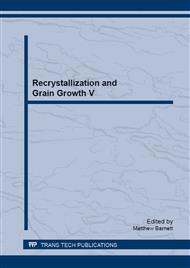p.469
p.473
p.477
p.481
p.485
p.489
p.493
p.497
p.501
Triple Junction Motion – A New Recovery Mechanism in Metals Deformed to Large Strains
Abstract:
A phenomenologically new recovery mechanism – triple junction motion is presented. This recovery mechanism is found to be the dominant one at low and medium temperatures in highly strained aluminum, which has a very fine microstructure, composed of lamellae with the thickness of a few hundred nanometers. Triple junction motion leads to removal of thin lamellae and to a consequent increase of the thickness of neighboring lamellae. This recovery mechanism therefore increases the average lamellar boundary spacing and causes a gradual transition from a lamellar structure to a more equiaxed structure preceding recrystallization.
Info:
Periodical:
Pages:
485-488
Citation:
Online since:
March 2013
Authors:
Price:
Сopyright:
© 2013 Trans Tech Publications Ltd. All Rights Reserved
Share:
Citation:


